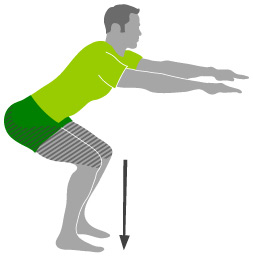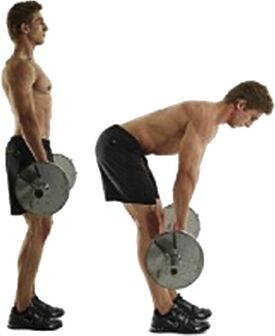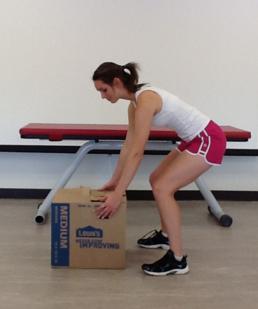Hip Hinge
Introduction[edit | edit source]
The hip hinge is a movement where the thoracic and lumbar spine and pelvis stay in a relatively neutral position while the subject bends forward. The movement comes from the hips rather than allowing the thoracic and lumbar spines to flex or round. The inability to perform this movement places the spine at end of range of motion and leaves the spine prone to acute and chronic injuries.
- It is utilized as an exercise to develop the posterior chain and to teach lumbopelvic disassociation. The muscles of the posterior chain include the gluteals, hamstrings, and low back. This exercise also relies on your core muscles to assist in the movement.
- The main cause of inability to hip hinge is lack of mobility in the lower quarter eg hip rotators and the hamstrings.[1]
Technique[edit | edit source]
Many beginners use a dowel rod held on the back for cuing.
- Stand with the feet shoulder width apart.
- Hold a dowel rod along the length of the back (center of the spine) with one hand behind the neck and other behind the low back with the dowel rod touching back of the head, thoracic Spine (upper middle back) and sacrum (base of the spine)[2].
- Ensure knees are not pulled forwards or collapsed inwards.
- With the spine in a neutral position, contract the core muscle and
- Then, tilt pelvis forwards and slowly bend the trunk forward at the hips while maintaining the position of the spine. Here, the dowel gives cuing so the lumbar spine does not round.
- Feel the stretch in the hamstrings and once the desired end range is reached, return to the start position.
Uses[edit | edit source]
The hip hinge has been a fundamental movement used to teach a variety of different activities. Below are a few examples.
- The hip hinge is a fundamental movement pattern, is used to perform essential tasks such as bending over and picking things up. It can beneficial when teaching someone how to lift from the ground while dealing with back pain.
- Rehabilitation: The hip hinge exercise can help strengthen the posterior chain and core muscles (which may lead to reduced back pain), improved balance, and improved flexibility.[3]
- Exercise: It an important technique used in many strength workouts e.g. the squat, kettlebell swings and the dead lift.
- Sports: Golfers teach a hip hinge to position the player in the proper position to strike the ball.
Research[edit | edit source]
There has been limited research on the use of the hip hinge alone. However, one study did find that utilizing the hip hinge movement did decrease subjects reported pain with testing movements[4]. Another study measuring the immediate effect of hip hinge exercise stretching on hamstring flexibility, pelvic tilting angle, proprioception, and dynamic balance in 36 healthy young adults with hamstring tightness found out that hip hinge exercise stretching was the most effective method for increasing hamstring flexibility, pelvic tilting angle and dynamic balance. However, further research needs to be done in patients with chronic low back pain with hamstrings tightness[5].
References[edit | edit source]
- ↑ Tyson A. “Hip-Hinge” to a Healthy Back. Strength & Conditioning Journal. 2001 Apr 1;23(2):74. Available: https://journals.lww.com/nsca-scj/Citation/2001/04000/_Hip_Hinge__to_a_Healthy_Back.18.aspx(accessed 24.8.2022)
- ↑ Michaud F, Pérez Soto M, Lugrís U, Cuadrado J. Lower Back Injury Prevention and Sensitization of Hip Hinge with Neutral Spine Using Wearable Sensors during Lifting Exercises. Sensors. 2021 Aug 14;21(16):5487.
- ↑ Very well fit How to Do a Hip Hinge Available: https://www.verywellfit.com/how-to-do-a-hip-hinge-4685934(accessed 24.8.2022)
- ↑ Ikeda, D. M., & McGill, S. M. (2012). Can altering motions, postures, and loads provide immediate low back pain relief: a study of 4 cases investigating spine load, posture, and stability. Spine, 37(23), E1469-E1475.
- ↑ Jung M, Kim N, Lee Y. Immediate Effect of Hip Hinge Exercise Stretching on Flexibility of Lower Limb, Pelvic Tilting Angle, Proprioception and Dynamic Balance in Individual with Hamstring Tightness. Physical Therapy Rehabilitation Science. 2022 Jun 30;11(2):259-68.









